Did you know that mid-rise and high-rise buildings can now be built out of wood? Mass timber is quickly gaining momentum as a viable alternative to traditional construction methods.
What is mass timber? What is mass timber made of?
Mass timber is an emerging building typology that replaces steel, masonry, and concrete with wood. With mass timber, architects and engineers can pursue sustainable construction, warmer aesthetics, and remarkable improvements in construction efficiency.
Although mass timber is a relatively new category, it already features a wide variety of products. Below, we’ll cover nail-laminated timber, glued-laminated timber, dowel-laminated timber, and the mass timber product gaining the most traction: cross-laminated timber.
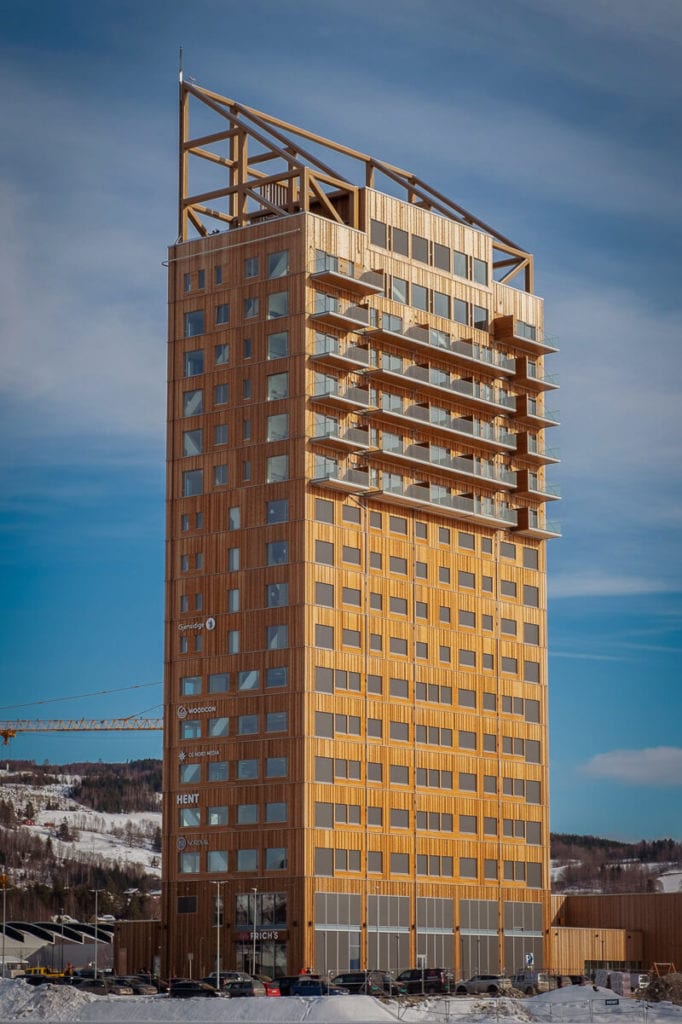
What’s the big deal with mass timber?
Because of the potential to significantly reduce carbon emissions in the atmosphere and reverse climate change, these benefits are plausible due to two key facts about construction:
- First, carbon emissions from the building industry account for approximately 40% of global carbon emissions.
- Second, the manufacture of concrete and steel contributes about 10% of current global carbon emissions.
Andrew Ruff of Connecticut-based Gray Organschi Architecture explains, “If you look 30 years down the road to 2050, we’re projected to have 2.3 billion new urban dwellers. That is a huge amount of construction. Every day that goes by that we don’t convert from mineral-based extractive construction techniques to carbon sequestering building systems, we tend to dig ourselves further in a hole” (Yale Environment 360: As Mass Timber Takes Off, How Green is this New Building Material?, April 2019).
Conversely, using wood in mass timber building actually removes carbon dioxide (CO2) from the atmosphere. Scientists refer to the process as carbon sequestration, but we like to think of wood as a carbon sponge. A tree is nature’s solar-powered CO2 storage machine, until the day it dies. Then, if left to rot—whether in a forest or landfill, or the wood burned—the sponge is wrung out and the CO2 returned to the atmosphere.
Here’s where it gets interesting: take that same wood and keep it dry, as part of a building in the form of mass timber—whether a timber frame, glulam trusses, or cross-laminated timber walls and floors—and it will last indefinitely. Hundreds of years. Longer than concrete.
Mass timber is part of the solution to our climate change problem.
What to Know About Mass Timber
The term mass timber might be confusing to some of us. First things first – a mass timber definition: the term mass timber refers to a building typology—a way in which the building itself is made of large, solid wood structural pieces for wall, floor, and roof construction.
What is Mass Timber Made Of?
As large solid pieces of timber become more expensive to source, mass timber is being fabricated using many smaller individual pieces of wood—literally tons of wood go into the making of these manufactured structural pieces. With mass timber, the large engineered wood structures of a building are made entirely of wood—usually the beams, columns, arches, floors and roofs—and fabricated offsite to engineered specifications.
Hence, the term mass refers to the large, solid components, and the term timber refers to a solid or manufactured wood product.
What is a Mass Timber Building?
One more thing that might help – the criterion to define a mass timber building is as follows: If the primary load-bearing structure is made of either engineered or solid wood, we can call it a mass-timber building. If the building uses mass timber as an accent and not as a primary structural element, then it is not mass timber. (Construction Dive: Mass Timber 101: Understanding the Emerging Building, May 2017)
Advantages of Mass Timber
- Faster and Cheaper Construction: Because mass timber is fabricated and sometimes even assembled offsite, it allows for a more efficient and more cost-effective construction process.
- Improved Fire and Earthquake Safety: In contrast to stick-built structures, mass timber buildings are more fire resistant—largely due to the larger, heavier, and more compressed timber.
- Reduced Emissions: Steel and concrete are highly embodied building materials—meaning they produce a tremendous amount of carbon emissions. Mass timber is made from wood, which is a carbon sink and a renewable resource.
Types of Mass Timber Systems
- Post and Beam: With its vertical posts and horizontal beams, post and beam construction is ideal for buildings with open interior spaces. Although it’s related to timber framing, post and beam uses metal connectors and fasteners.
- Floor and Wall: Mass timber can completely replace steel and concrete to form floors and walls of mid- and high-rise buildings. Floor and wall systems often use a honeycomb structure to manage vertical and lateral loads.
- Hybrid Systems: In addition to timber, hybrid systems include materials like concrete and steel. With hybrid systems, you can choose the best material for the job while still enjoying the benefits of mass timber.
What are the most common timber products?
Sawn Solid Timber (timber framing, post & beam construction)
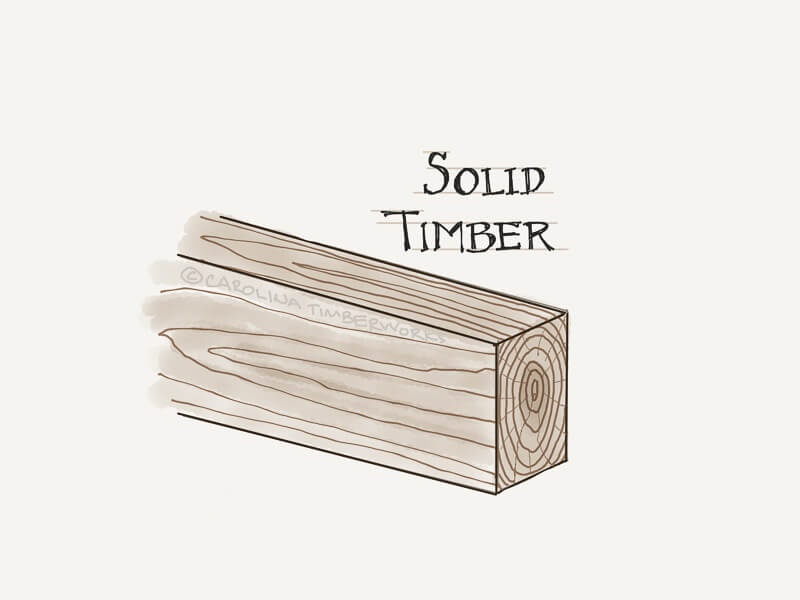
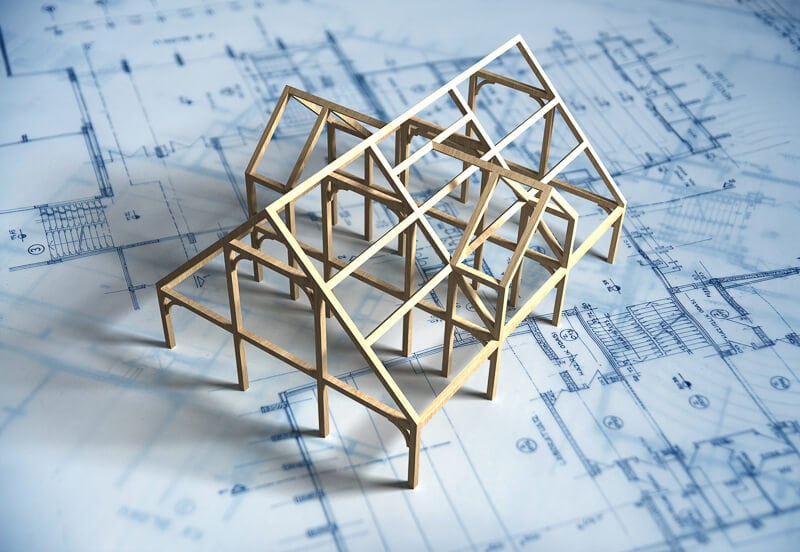
Traditional timber framing is the more than 2,000 year old building method (some would argue it’s an art) of connecting two or more pieces of timber using wood-to-wood joinery. Prior to the discovery of metal, this is how timber posts and beams were connected to frame the homes, barns, and businesses our ancestors lived and worked in. Held together without nails, bolts, or metal connectors—timber frames tend to withstand the test of time—many with a lifespan measured in centuries instead of decades.
What is a timber frame? Learn more.
What’s the difference between timber frame and post and beam construction? Learn more.
Glue-laminated Timber (glulam)

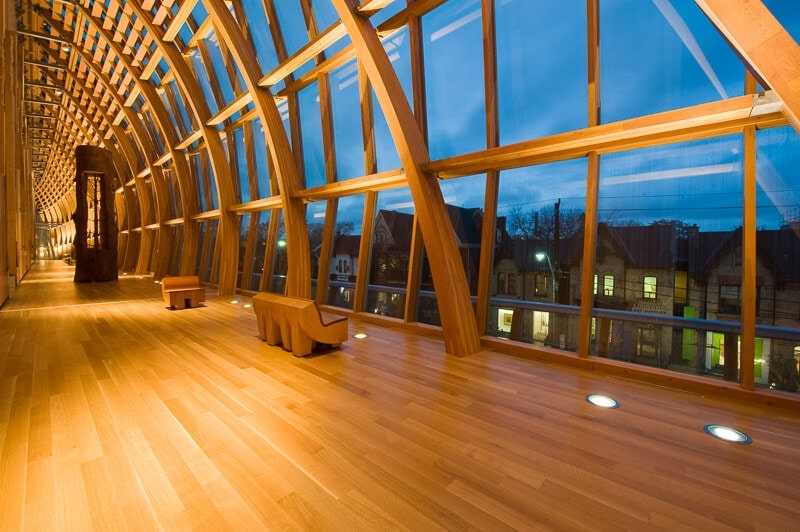
Glued laminated timber (glulam) is an engineered wood product made by laminating smaller pieces of solid lumber together with moisture-resistant adhesives into a single, usually large and very strong, structural member. These large structural members are used to create vertical columns, horizontal beams and floors, as well as curved arches.
Glulam technology allows architects to design bold curved shapes, in a range of wood species and appearances. And because of their strength and stiffness, glulam timbers can be used to create beams and arches that span large distances—up to 300 feet—without using supporting columns.
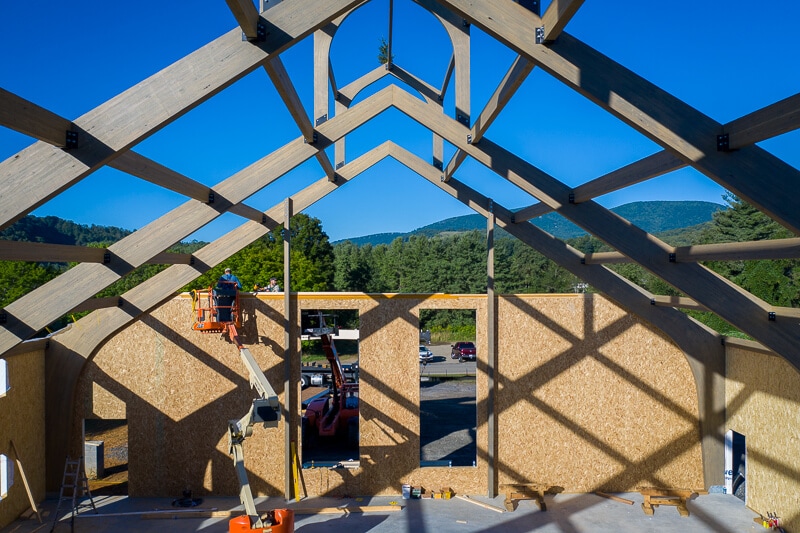
Cross-laminated Timber (CLT)
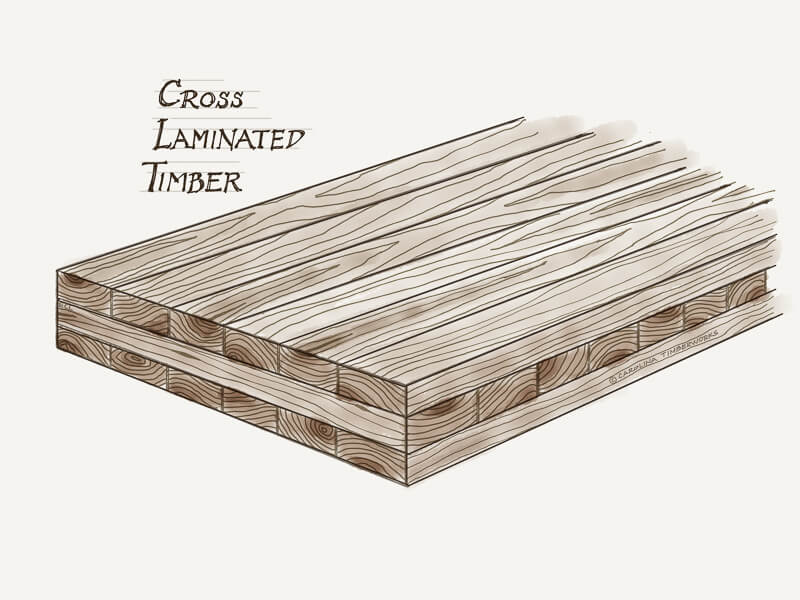
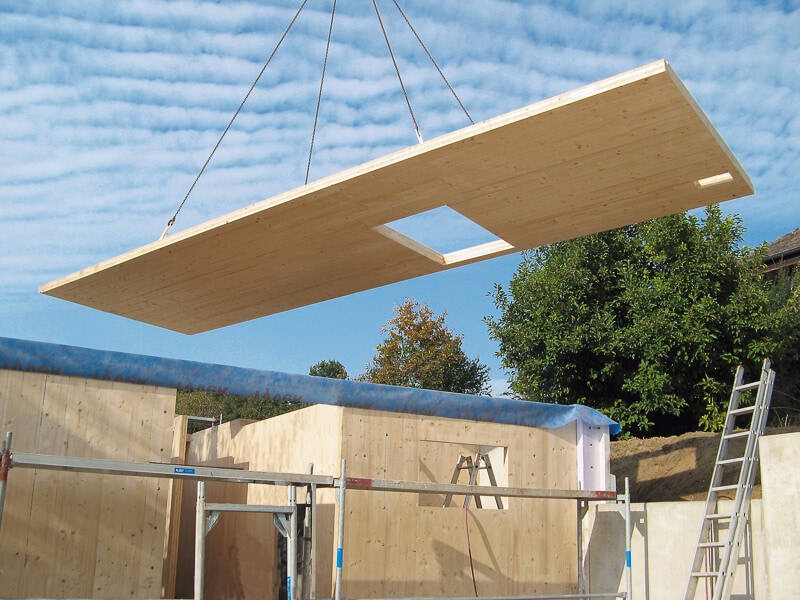
CLT was first developed in Germany and Austria in the early 1990s in response to an increasing shortage of old-growth timber. A CLT is a large, prefabricated, engineered solid-wood panel commonly used for long spans in walls, floors, and roofs. Finished panels are typically 2 to 10 feet wide, with lengths up to 70 feet and thicknesses up to 20 inches. They are light-weight and very strong, with superior acoustic, fire, seismic, and thermal performance.
CLT’s are manufactured by combining layers of lumber boards which are stacked in alternating directions, then bonded with structural adhesives, and finally pressed together to form a solid rectangular panel. CLT’s are fast and easy to install, and because they are engineered and fabricated offsite, do not generate any waste at the jobsite. As an alternative to traditional concrete and steel, CLT’s are eco-friendly, offer increased design flexibility, provide better thermal insulation, and lower construction costs due to prefabrication. Did we mention that they are beautiful to look at?
Nail-laminated Timber (NLT)
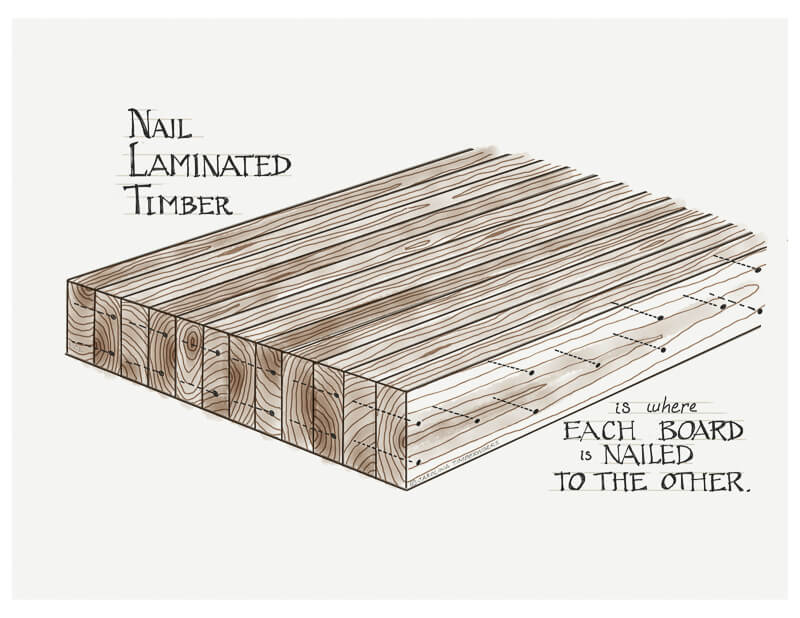
Nail-laminated timber (NLT). NLT has been around for more than a century, and used to be known as heavy timber or mill decking. To create an NLT, you simply stack layers of dimensional lumber on end and fasten them together with nails or screws. NLT is commonly used in floors and roofs as a valid substitute for concrete slabs and steel decking, with the added benefit of creating a unique, exposed wood aesthetic.
Whereas CLT is a newer technology in North America, and not always fully understood by building inspectors, NLT works well for simple spans—it’s also less expensive, and is firmly accepted in the building codes. The downside? Your saw is not going to be happy if you have to cut openings in NLT panels.
Dowel-laminated Timber (DLT) (no glue, no nails)
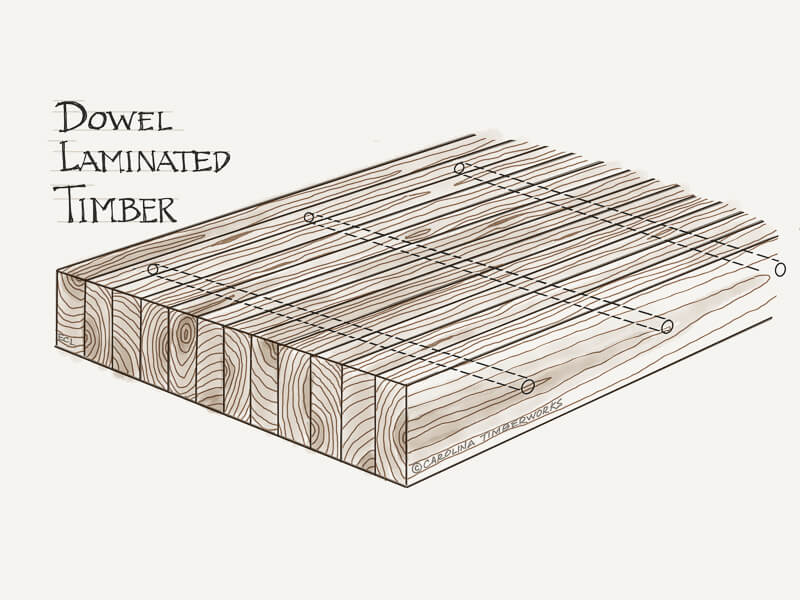
Dowel-laminated timber (DLT). The same as NLT, except instead of using glue or nails to fasten the lumber, wooden dowels are used. A major benefit is the lack of off-gassing from adhesives.
Why invest in mass timber?
Besides offering a low-carbon alternative to traditional building technology, the exposed wood interiors in mass timber buildings are warmer than other materials and far more aesthetically pleasing that concrete and steel. People love them, and literally want to hug the wooden interiors. This is because there’s still no other building material quite as warm and welcoming as wood.
In addition to the calming psychological effects of living in a wooden building, there are the physiological benefits. The buildings actually smell of wood, usually pine and spruce.
One last reason might convince you to consider CLT—the business case—developers and builders using mass timber are getting a lot of attention.
If you are getting really inspired about wood buildings, we recommend watching Michael Green’s TedTalk on “Why we should build wooden skyscrapers”
Carolina Timberworks is proud to design, fabricate, and install timber framing, glulams, and CLT panels anywhere in the United States, starting in our home of North Carolina. Send us a message or call us at 828-266-9663 to learn more.
Inquiries
Architect Contact
Curious about how buildings can be part of the solution to climate change? Read our review of Bruce King’s book, The New Carbon Architecture.